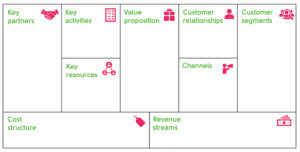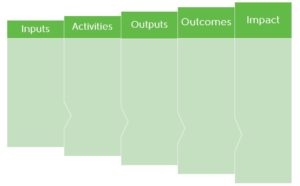At its simplest level, your business model describes how you monetise what you do. From a business resilience perspective, it’s important to understand the detail of your business model and to know your strengths and vulnerabilities, so you can play to your strengths, and monitor and protect yourself against anything that might hit you in your weak spot.
There are several different tools for describing your business model, and these can help you to build your understanding of how your organisation works currently, and to plan your next idea. You may have more than one business model in your organisation, depending on the range of products and services you offer, and how they are funded.
The basic starting point for describing your business model addresses three key questions:
- What products and services do you offer?
- Who are your customers?
- How do you get paid?
It sounds simple, but I’ve lost count of the number of entrepreneurs I’ve met, particularly in the for-purpose space, who have a great idea, but haven’t worked out how to monetise it. Then there are the established organisations who describe their target market as ‘everyone’. You might have a really clear idea for the product or service you want to offer, but defining your target market and working out how you’ll be paid can be a lot tougher. Understanding these three points is critical to your business model.
And then they might change… For example, newspapers used to generate their revenue through sales of hard copy newspapers, and advertising. But with so much free online content now, this has become really challenging – forcing news media to adapt the ‘how do you get paid’ aspect of their service to subscription models or voluntary ‘pay what you feel’ contributions. From a not for profit sector perspective, the shift from block funding contracts in advance to individualised payment for services, in arrears, has resulted in a significant change in how they are paid. And it’s not just the revenue aspect of the business that’s been affected, with a lot of flow-on implications for other areas, such as working capital, staffing and infrastructure. Our experience of working with organisations in this space demonstrated that many did not understand or adequately prepare for the implications of such a significant change in how they were paid.
So getting to grips with these three elements is important, and once you have, you can use a business model tool that helps you to work at a more granular level. As we’ve seen from the examples above, changes in one of these three areas can have significant implications of multiple aspects of your organisation, so building a more detailed understanding of how everything is connected is vital. If we go back to our newspaper example, their distribution channel has shifted from sales through newsagents, to online distribution, and that has required a much quicker turnaround from content development to publication.
Business Model Canvas

We like business model canvas as it’s a very visual way of describing your business model. Originally developed by Alexander Osterwalder and Yves Pigneur, it can be used to plan a new business model, understand your existing model or understand your competitors’ models. If you have multiple products and services, or different departments, it’s worth mapping them separately first, before looking at your business as a whole.
These are the features of the business model canvas:
- Value proposition: this sits at the centre of the canvas and describes your product or service, and the value it provides to the customer. You can think of the value as the problem that you are solving for the customer, or the benefit that they are getting from your product. This is critical to your market and competitive position.
- Key partners: these are the people you rely on to do business, so they could include – for example – referral agencies
- Key activities: these are your everyday activities that are critical to running your business
- Key resources: in the not for profit sector, your people are likely to be your most significant resource, but also consider other key resources, such as knowledge, data, facilities, and funds
- Cost structure: understanding your key resources and activities will help you to calculate your most significant costs
- Customer segments: this drills down into the detail of the types of customers you serve. In the not for profit sector, they are often defined by lived experience – such as a disability, caring responsibility, age, cultural background, socio economic factors etc, and – if you are servicing a particular geographical community – by location. For example you may support carers of children with life-limiting illnesses in regional Victoria. The clearer you can be about your customer segments, the better able you will be to describe your value proposition – or the difference you make to your customers.
- Customer relationships describes the nature of the relationship and how it’s maintained. For example you might support customers through a very personal one to one relationship, or it may be more automated and transactional.
- Channels: this is the one aspect of business model canvas that we find a bit problematic, as it includes both how you communicate with your customer, and how you deliver the value proposition. We think these are actually two separate things (and you need to understand both).
- How you communicate: these are your marketing and communication channels – so include your route to winning new customers, and communicating with (and retaining) the customers you have.
- How you deliver your value proposition: this is the place where your customers access your services – so it could be at your premises, in their home, in the community, via a third party, etc. As discussed above in our example about news media, the place where we access their product has now shifted (largely) from newsagents, to online.
- Revenue streams: this is how you make money
Applying this model to your existing business may give you some useful insights into your strengths as a business, or may identify some gaps in your model or areas where you’re not performing so well. If you offer multiple different products and services, mapping each across the canvas may reveal some interesting insights. For example, you may find that your customer segments are more diverse than you thought, or that you are delivering service through multiple different channels. You can then start unpacking this a bit more – where does diversity provide some risk mitigation by avoiding over reliance on a single model, and where is it spreading you too thin? What are the efficiency opportunities to consolidate across teams? Can you engage your key partners to support you in delivering more of your products and services? As such, business model canvas can be a useful tool to drive discussions about business improvements or change, and to identify new partnerships or initiatives.
However, business model canvas is primarily a commercial tool. It doesn’t discuss social impact, although a creative interpretation could integrate impact into your value proposition. If you want a model with more of a focus on social impact, try the theory of change.
Theory of Change

Many not for profits will be familiar with theory of change. It’s been widely applied in the sector as a tool for planning and measuring social change, and is integrated into many grant funding programs as a means of demonstrating how funded projects deliver social impact. We used it with clients as part of our ILC Ready program, supporting organisations to design disability inclusion projects, and observed its value from a business model perspective. Theory of Change describes how you will achieve change, and you can only design a solid Theory of Change if you have a really strong understanding of your customer segment and the problem you’re trying to solve for – or with – them. You can probably map your existing model against business model canvas (at a high level) fairly quickly – but theory of change is generally a more complex, longer process requiring stakeholder input and some deep thinking about how you deliver social change. It assumes you start the process with strong engagement from stakeholders, so you have a solid, real world understanding the problems you are trying to solve, and options for their resolution. Working through the process, you’ll design your service (activities) and products (outputs or deliverables).
Unlike business model canvas, it describes what success looks like (in terms of outcomes and impact) and normally includes measures for each. The inputs section describes the resources required, which can then be developed into your costs, and a well developed Theory of Change will also include your assumptions, your stakeholders, and a review of the critical success factors that need to be in place for your planned outcomes to be achieved. These are all great food for your risk register. But – have you spotted the gap yet? A standard theory of change doesn’t normally describe how you are paid for your service. This is possibly because it’s largely been applied for philanthropy and grant making, with the theory of change acting as the core aspect of the funding proposal and outcome measurement. In the modern not for profit funding environment, if you’re using theory of change to design your service or business model outside of the grant funding context, it leaves a gap you’ll need to fill.
We said earlier in this article that your organisation may have more than one business model in terms of the products and services you offer, and you may need to map each one. If that’s the case, it might be that you can map multiple services using one tool to articulate what you do – for example by mapping each of your products against the business model canvas. If you want to look for synergies -or conflicts – between different aspects of your business, this is certainly what we’d recommend. Your organisational culture, and your existing understanding of your strengths, weaknesses and gaps, is likely to have you leaning more towards business model canvas or theory of change. But you might want to use both. If your model involves making a profit in one area of the business in order to fund for-purpose activity in another, you have the option of using business model canvas to map your money maker, and theory of change to design and articulate your impact program.
One size does not fit all. It may be that none of these models are right for you and your organisation, but if they are initiating a conversation and developing a shared language about your business model, and building understanding of what you do and how you operate, and raising awareness of your business risks, you are on the road to increasing your resilience.






